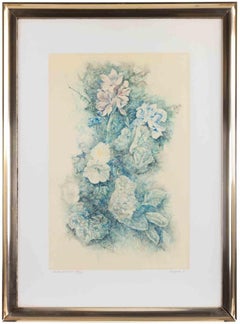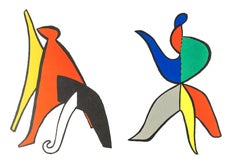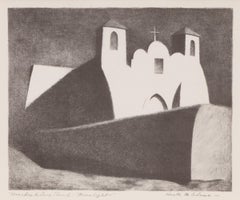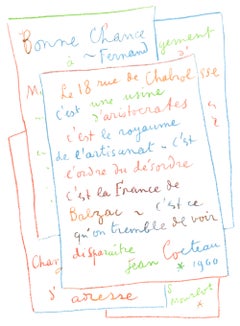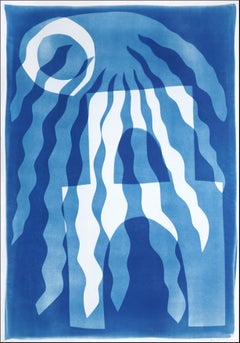Lithograph Still-life Prints
to
604
655
241
318
140
33
Overall Width
to
Overall Height
to
393
135
103
84
52
43
41
40
15
12
11
2
1
36
27
27
27
18
3
112
1,192
80
10
9
23
7
75
194
241
209
189
48
915
443
26
240
207
188
161
122
118
85
80
70
67
51
49
45
41
40
39
36
36
32
30
1,387
984
612
578
393
123
254
973
230
Medium: Lithograph
Flowers - Lithograph by Renzo Vespignani - 1980
Located in Roma, IT
Flowers is a modern artwork realized by Renzo Vespignani in 1980.
Mixed colored lithograph.
Hand signed and dated on the lower margin.
Numbered on the lower left.
Artist's proof....
Category
1980s Modern Lithograph Still-life Prints
Materials
Lithograph
Alexander Calder, Clog and Phrygian Cap, from Derriere le Miroir, 1963
Located in Southampton, NY
This exquisite lithograph by Alexander Calder (1898–1976), titled Sabot et le bonnet phrygien (Clog and Phrygian Cap), originates from the historic 1963 folio Derriere le Miroir, No....
Category
1960s Surrealist Lithograph Still-life Prints
Materials
Lithograph
Kenneth Miller Adams Moonlit Ranchos de Taos Church, 1950 Signed Lithograph
Located in Denver, CO
This evocative 1950 original lithograph by celebrated New Mexico artist Kenneth Miller Adams offers a hauntingly beautiful moonlit view of the iconic San Francisco de Asís Mission Ch...
Category
1950s American Modern Lithograph Still-life Prints
Materials
Lithograph
6 Camellias After An Unknown Japanese Artist
Located in San Francisco, CA
This artwork titled "6 Camellias After An Unknown Japanese Artist" 1988 is a original color lithograph on Wove paper by noted American artist Gary Bukovni...
Category
Mid-20th Century American Realist Lithograph Still-life Prints
Materials
Lithograph
Jean Cocteau, Manuscript, from Memories and Portraits of Artists, 1972 (after)
By Jean Cocteau
Located in Southampton, NY
This exquisite lithograph after Jean Cocteau (1889–1963), titled Manuscrit (Manuscript), originates from the 1972 edition published by Editions A. C. Mazo et Cie., Paris, in collabor...
Category
1970s Modern Lithograph Still-life Prints
Materials
Lithograph
$716 Sale Price
20% Off
Home Away From Home, Desert Modernism Architecture, Blue Tones Cyanotype, Paper
By Kind of Cyan
Located in Barcelona, ES
This is an exclusive handprinted unique cyanotype that takes its inspiration from the mid-century modern shapes and the desert modernism movement.
It's made by layering paper cutouts...
Category
2010s Naturalistic Lithograph Still-life Prints
Materials
Paper, Monotype, Lithograph
AIRPLANE Hand Drawn Signed Lithograph, Vintage Wood Plane Tool, Blue Sky, Clouds
Located in Union City, NJ
AIRPLANE is a hand drawn limited edition lithograph by the American surrealist artist Fanny Brennan, created using traditional hand lithography techniques printed on archival Arches ...
Category
1990s Surrealist Lithograph Still-life Prints
Materials
Lithograph
Hillside Place, Modern Lithograph by Robert Kipniss
Located in Long Island City, NY
Robert Kipness was an American painter and printmaker who’s work focused on forms and a pronounced moodiness. This print is signed, numbered, dated, and...
Category
1980s American Impressionist Lithograph Still-life Prints
Materials
Lithograph
Snowy Feverfew, English antique red flower botanical chromolithograph, 1895
By Frederick William Hulme
Located in Melbourne, Victoria
'Snowy Feverfew'
Process print from Frederick William Hulme’s ‘Familiar Wild Flowers’, circa 1890.
Hulme was known as a teacher and an amateu...
Category
Late 19th Century Naturalistic Lithograph Still-life Prints
Materials
Lithograph
Magritte, Sans titre, View, Surrealism in Belgium (after)
Located in Southampton, NY
Lithograph on vélin paper. Paper Size: 12 x 9 inches. Inscription: Signed in the plate and unnumbered, as issued. Notes: From the album, View, Surrealism in Belgium, vol. VII, n°2, D...
Category
1940s Surrealist Lithograph Still-life Prints
Materials
Lithograph
$716 Sale Price
20% Off
Large-Leaved Saxifrage, English antique flower botanical chromolithograph, 1895
By Frederick William Hulme
Located in Melbourne, Victoria
'Large-Leaved Saxifrage'
Process print from Frederick William Hulme’s ‘Familiar Wild Flowers’, circa 1890.
Hulme was known as a teacher and an amateur botanist. He was the Professo...
Category
Late 19th Century Naturalistic Lithograph Still-life Prints
Materials
Lithograph
Alexander Calder, The Moon and the Prickly Pig, from Derriere le Miroir, 1963
Located in Southampton, NY
This exquisite lithograph by Alexander Calder (1898–1976), titled La lune et porc qui pique (The Moon and the Prickly Pig), originates from the historic 1963 folio Derriere le Miroir...
Category
1960s Surrealist Lithograph Still-life Prints
Materials
Lithograph
Original Arabic Art - Spain vintage travel poster
By José Ortega
Located in Spokane, WA
Original Arabic Art – Spain vintage travel poster. Artist: Jose Ortega. Size: 24.5" x 39.5". C. 1950. Original vintage European travel poster...
Category
1950s Abstract Geometric Lithograph Still-life Prints
Materials
Lithograph
$620 Sale Price
20% Off
Room For Montgomery, abstract lithograph sky blue clouds, Jim Alford, Santa Fe
By Jim Alford
Located in Santa Fe, NM
Alford lives and paints on the Galisteo plain just southwest of Santa Fe. His home and studio are situated on a land swell from which the view can only be described as wholly open, e...
Category
1990s Contemporary Lithograph Still-life Prints
Materials
Lithograph
“Teal Bouquet”
Located in Southampton, NY
Original colored lithograph of a bouquet in teal by the well known French artist, Claude Gaveau. Edition 5/175 in pencil lower left margin. Signed in pencil by the artist lower right...
Category
1980s Post-Modern Lithograph Still-life Prints
Materials
Archival Paper, Lithograph
$460 Sale Price
20% Off
Vuillard, Bouquet De Fleurs, Douze pastels (after)
Located in Southampton, NY
Lithograph and stencil on vélin paper mounted on backing museum board, as issued. Unsigned and unnumbered, as issued. Good condition. Notes: From the folio, Vuillard, Douze Pastels P...
Category
1960s Post-Impressionist Lithograph Still-life Prints
Materials
Lithograph, Stencil
$1,996 Sale Price
20% Off
Cymbidium Eburneum, antique orchid botanical lithograph print, 1859
Located in Melbourne, Victoria
'Cymbidium Eburneum – The Ivory Cymbidium'
Orchid lithograph with original hand-colouring , 1859, by Walter Hood Fitch (1817-1892).
25cm by 15.5cm (sheet...
Category
Mid-19th Century Naturalistic Lithograph Still-life Prints
Materials
Lithograph
Braque, L'oiseau Jaune, Derrière le miroir (after)
Located in Southampton, NY
Lithograph on vélin paper. Inscription: Unsigned and unnumbered, as issued. Good condition, with centerfold, as issued. Notes: From Derrière le miroir, N° 115, 1959. Published by Aim...
Category
1950s Modern Lithograph Still-life Prints
Materials
Lithograph
$796 Sale Price
20% Off
Table with a Pipe and a Bottle - Lithograph, Mourlot
Located in Paris, IDF
Chaim SOUTINE (1893-1943)
Table with a Pipe and a Bottle
Stone lithograph after a painting (Mourlot workshop)
Printed signature in the plate
On Arches vellum 50 x 65 cm (c. 20 x 26 ...
Category
1970s Expressionist Lithograph Still-life Prints
Materials
Lithograph
Henri Matisse, Creole Dancer, from Verve, Revue Artistique, 1958 (after)
Located in Southampton, NY
This exquisite lithograph after Henri Matisse (1869–1954), titled Danseuse Créole (Creole Dancer), from Verve, Revue Artistique et Litteraire, Vol. IX, No. 35–36, originates from the 1958 issue published by Editions de la revue Verve, Paris, under the direction of Teriade, Editeur, Paris, and printed by Mourlot Freres, Paris, 1958. Danseuse Créole celebrates Matisse’s mastery of rhythm and movement through his iconic cut-out technique, transforming color and form into pure visual music. The composition captures a dancer in motion—her form abstracted into vibrant, flowing shapes that express both energy and grace. Evoking the sensuality and vitality of dance, this work embodies Matisse’s lifelong quest to unite color, joy, and human expression in perfect harmony.
Executed as a lithograph on velin du Marais paper, this work measures 14 x 10.5 inches. Signed in the plate and unnumbered as issued. The edition exemplifies the superb craftsmanship of the Mourlot Freres atelier, faithfully capturing the coloristic richness and compositional rhythm of Matisse’s late paper cut-outs.
Artwork Details:
Artist: After Henri Matisse (1869–1954)
Title: Danseuse Créole (Creole Dancer), from Verve, Revue Artistique et Litteraire, Vol. IX, No. 35–36, 1958
Medium: Lithograph on velin du Marais paper
Dimensions: 14 x 10.5 inches
Inscription: Signed in the plate and unnumbered as issued
Date: 1958
Publisher: Editions de la revue Verve, Paris, under the direction of Teriade, Editeur, Paris
Printer: Mourlot Freres, Paris
Catalogue raisonne reference: Duthuit, Claude. Henri Matisse: Catalogue raisonne des ouvrages illustres. Editions Claude Duthuit, Paris, 1988, illustration 139
Condition: Well preserved, consistent with age and medium
Provenance: From Verve, Revue Artistique et Litteraire, Vol. IX, No. 35–36, published by Editions de la revue Verve, Paris, 1958
Notes:
Excerpted from the publication, Verve, Revue Artistique et Litteraire, Vol. IX, No. 35–36, published under the direction of Teriade, Editeur, Paris, and printed by Mourlot Freres, Paris, 1958. This double issue of Verve was entirely devoted to the final works of Henri Matisse, composed of his celebrated gouache cut-outs, which the artist called “painting with scissors.” Completed shortly before his death, this issue represents the culmination of Matisse’s lifelong exploration of color, rhythm, and spiritual joy through the simplest means of expression.
About the Publication:
Verve, Revue Artistique et Litteraire was one of the most influential art periodicals of the 20th century, founded in Paris in 1937 by the visionary Greek-born publisher Teriade (Stratis Eleftheriades). Conceived as a synthesis of art and literature, Verve brought together the greatest modern artists and writers of its time—Henri Matisse, Pablo Picasso, Marc Chagall, Georges Braque, Joan Miro, Fernand Leger, and others—alongside poets and philosophers such as Paul Eluard, Albert Camus, and Jean-Paul Sartre. Each issue was a work of art in itself, luxuriously printed by master lithographers such as Mourlot Freres and produced in collaboration with leading typographers and designers. Verve became a platform for avant-garde creativity, publishing original lithographs and essays that reflected the evolving spirit of modernism. Matisse collaborated closely with Teriade from the magazine’s inception, producing some of its most iconic issues, including those devoted to his paper cut-outs. The final Verve issue of 1958, which featured La Tristesse du Roi, the Nu Bleu series, Poisson Chinois, and Danseuse Créole, stands as a testament to Matisse’s enduring genius and to the publication’s legacy as the definitive meeting of art, poetry, and printing craftsmanship in 20th-century France.
About the Artist:
Henri Matisse (1869–1954) was a French painter, sculptor, draughtsman, and printmaker whose revolutionary vision redefined modern art through his daring use of color, line, and form. Celebrated as one of the greatest artists of the 20th century, Matisse led the Fauvist movement and devoted his life to the pursuit of balance, beauty, and emotional expression in visual art. His early works burst with vibrant hues and liberated brushwork, while his later “cut-out” compositions achieved a poetic simplicity that transformed the relationship between color and space. Deeply influenced by the work of Paul Cezanne, Vincent van Gogh, and Georges Seurat, as well as by the rhythmic patterns of Islamic art, Byzantine mosaics, and Japanese prints, Matisse forged a new visual language that celebrated joy, movement, and serenity. He was part of an extraordinary generation of artists who shaped the evolution of modernism, maintaining lifelong dialogue and friendly rivalry with contemporaries such as Pablo Picasso, Georges Braque, Marc Chagall, Andre Derain, Albert Marquet, and Raoul Dufy—peers who, like him, sought to expand the expressive potential of color and composition. Matisse’s influence extended across generations, inspiring modern and contemporary masters including Alexander Calder, Alberto Giacometti, Salvador Dali, Joan Miro, Wassily Kandinsky, Marcel Duchamp, and Man Ray, each of whom drew upon his fearless experimentation and refined visual harmony. His paintings, sculptures, and works on paper are held in the most prestigious museums in the world, including the Museum of Modern Art, the Centre Pompidou, the Tate, and the Hermitage Museum, where his art continues to symbolize the essence of creativity and human emotion. The highest price ever paid for a Henri Matisse artwork is approximately $80.8 million USD, achieved in 2018 at Christie’s New York for Odalisque couchee aux magnolias (1923).
Henri Matisse Danseuse...
Category
1950s Modern Lithograph Still-life Prints
Materials
Lithograph
$956 Sale Price
20% Off
Henri Matisse, Series G, Var. 3, Drawings, Themes and Variations, 1943 (after)
Located in Southampton, NY
This exquisite lithograph after Henri Matisse (1869–1954), titled Serie G, var. 3 (Series G, Variation 3), from the album Henri Matisse, Dessins, Themes et Variations (Drawings, Them...
Category
1940s Modern Lithograph Still-life Prints
Materials
Lithograph
$796 Sale Price
20% Off
Calder, Sans titre, Musée National d'Art Moderne, Paris (after)
Located in Southampton, NY
Lithograph on vélin paper. Paper Size: 12.5 x 9.25 inches. Inscription: Unsigned and unnumbered, as issued. Notes: From the album, Calder. Published and printed by Musée National d'A...
Category
1960s Modern Lithograph Still-life Prints
Materials
Lithograph
$716 Sale Price
20% Off
Georges Braque, The Studio, from Derriere le Miroir, 1964 (after)
Located in Southampton, NY
This exquisite lithograph after Georges Braque (1882–1963), titled L’Atelier (The Studio), originates from the 1964 folio Derriere le Miroir, Nos. 144–145–146, L’Hommage a Georges Br...
Category
1960s Cubist Lithograph Still-life Prints
Materials
Lithograph
$716 Sale Price
20% Off
Alexander Calder, Anteater, from Derriere le Miroir, 1963
Located in Southampton, NY
This exquisite lithograph by Alexander Calder (1898–1976), titled Tamanoir (Anteater), originates from the historic 1963 folio Derriere le Miroir, No. 141. Published by Maeght Editeu...
Category
1960s Surrealist Lithograph Still-life Prints
Materials
Lithograph
$796 Sale Price
20% Off
Sangre de Vida, Pop Art Lithograph and 3-D collage by Rudy Fernandez
Located in Long Island City, NY
Rudy Fernandez, American (1948 - ) - Sangre de Vida, Year: 1984, Medium: Lithograph and 3-D collage, signed, numbered, titled and dated in pencil, Edition: 45/75, Size: 31.75 x 2...
Category
1980s Pop Art Lithograph Still-life Prints
Materials
Mixed Media, Lithograph
Green Flame, Modern Lithograph by Robert Beauchamp
Located in Long Island City, NY
Robert Beauchamp, American (1923 - 1995) - Green Flame, Year: 1980, Medium: Lithograph, signed and numbered in pencil, Edition: AP 25, Image Size: 25 x 24.5 inches, Size: 33 in....
Category
1980s Modern Lithograph Still-life Prints
Materials
Lithograph
Still life - Fruits, pears and apples - Lithograph, 1971
By Paul Cézanne
Located in Paris, IDF
Paul Cezanne
The green jug, 1971
Lithograph and stencil (Jacomet workshop)
Unsigned
Numbered / 225
On paper applied on Arches vellum 41.5 x 53.5 cm (c. 16.5 x 21 in)
INFORMATION : ...
Category
1970s Modern Lithograph Still-life Prints
Materials
Lithograph, Stencil
Hyacinths - Color Lithograph - Bernard Buffet
Located in Sint-Truiden, BE
These works were printed in November 1967 by Fernand Mourlot, master lithographer in Paris.
Category
1960s Lithograph Still-life Prints
Materials
Lithograph
Vase de Fleurs, Cubist Lithograph after Pablo Picasso
Located in Long Island City, NY
A lithograph from the Marina Picasso Estate Collection after the Pablo Picasso painting "Vase de Fleurs". The original painting was completed in 1958. In the 1970's after Picasso's ...
Category
1980s Modern Lithograph Still-life Prints
Materials
Lithograph
Dark Still Life Photography FIne Art Print - Natura Morte 3 by Koukouwitakis
Located in Winterswijk, NL
Dark Still Life Photography FIne Art Print - Natura Morte 3 by Koukouwitakis
From the series "Natura Morte" still life
The photographic image of the withered flowers, rotten fruit, ...
Category
21st Century and Contemporary Lithograph Still-life Prints
Materials
Giclée, Lithograph
Braque, Composition, Braque Espaces, 13 Dessins, Lavis, Aquarelles (after)
Located in Southampton, NY
Lithograph and stencil on vélin papier a la cuve du moulin richard de bas specialement filigrané pour cette édition paper. Inscription: signed in the plate and unnumbered, as issued....
Category
1950s Modern Lithograph Still-life Prints
Materials
Lithograph, Stencil
$3,996 Sale Price
20% Off
La Tasse et la Pomme (The Cup and the Apple)
Located in Fairlawn, OH
La Tasse et la Pomme (The Cup and the Apple)
Wash drawing and gouache transferred to lithograph stone, 1947
One of four unsigned proofs
Edition: a proof outside the edition of 50 pri...
Category
1940s French School Lithograph Still-life Prints
Materials
Lithograph
Fernand Leger, Still Life, from Derriere le miroir, 1955 (after)
Located in Southampton, NY
This exquisite lithograph after Fernand Leger (1881–1955), titled Nature morte (Still Life), from the folio Derriere le miroir, No. 79-81, originates from the 1955 edition published by Maeght Editeur, Paris, and printed by Mourlot Freres, Paris, 1955. This composition exemplifies Leger’s rhythmic balance of color, form, and movement, translating the mechanical vitality of modern life into a harmonious, humanized geometry.
Executed as a lithograph on velin paper, this work measures 15 x 11 inches. Signed in the plate and unnumbered as issued. The edition exemplifies the superb craftsmanship of Mourlot Freres, Paris.
Artwork Details:
Artist: After Fernand Leger (1881–1955)
Title: Nature morte (Still Life), from the folio Derriere le miroir, No. 79-81
Medium: Lithograph on velin paper
Dimensions: 15 x 11 inches (38.1 x 27.94 cm)
Inscription: Signed in the plate and unnumbered as issued
Date: 1955
Publisher: Maeght Editeur, Paris
Printer: Mourlot Freres, Paris
Condition: Well preserved, consistent with age and medium
Provenance: From the folio Derriere le miroir, No. 79-81, published by Maeght Editeur, Paris; printed by Mourlot Freres, Paris, 1955
About the Publication:
Derriere le miroir (Behind the Mirror) was one of the most important art publications of the 20th century, created and published by Maeght Editeur in Paris from 1946 to 1982. Founded by the visionary art dealer and publisher Aime Maeght, the series served as both an exhibition catalogue and a work of art in its own right, uniting original lithographs by leading modern and contemporary artists with critical essays, poetry, and design of the highest quality. Printed by master lithographers such as Mourlot Freres and Arte, Derriere le miroir became synonymous with the artistic vanguard of postwar Europe. Each issue was devoted to a single artist or theme and published to accompany exhibitions at the Galerie Maeght in Paris, featuring works by Pablo Picasso, Henri Matisse, Georges Braque, Joan Miro, Marc Chagall, Alexander Calder, Fernand Leger, and Alberto Giacometti, among others. The publication reflected Maeght's belief that art should be both accessible and elevated—an ideal realized through its luxurious production values, meticulous printing, and collaboration with the greatest creative minds of its time.
About the Artist:
Fernand Leger (1881–1955) was a visionary French painter, sculptor, designer, and filmmaker whose groundbreaking fusion of modern industry, vivid color, and geometric form transformed the course of 20th-century art. Born in Argentan, Normandy, Leger began as an architectural draftsman before studying at the Academie Julian and the Ecole des Beaux-Arts in Paris, where he absorbed the lessons of Paul Cezanne’s structural rigor and the revolutionary ideas of Cubism. Alongside Pablo Picasso and Georges Braque, he became one of the leading innovators of the avant-garde, yet his work stood apart through its embrace of mechanical rhythm, bold contrasts, and industrial modernity—earning him the title “the painter of the machine age.” His art celebrated the beauty of technology, urban life, and the human form rendered in dynamic, interlocking cylinders and planes, evoking the pulse of the modern world. Immersed in the vibrant Parisian art scene, Leger worked in dialogue with peers and contemporaries such as Alexander Calder, Alberto Giacometti, Salvador Dali, Joan Miro, Wassily Kandinsky, Marcel Duchamp, and Man Ray, all of whom shared his commitment to innovation and the reimagining of artistic expression. Beyond painting, Leger’s creative reach extended into film, design, and monumental public art—his 1924 collaboration on Ballet Mecanique with Dudley Murphy and Man Ray remains a landmark of avant-garde cinema. His later works evolved toward greater clarity and monumentality, celebrating the unity of form, color, and humanity through large-scale murals and mosaics that bridged fine art and architecture. Leger’s synthesis of Cubism, Futurism, and abstraction paved the way for movements such as Pop Art and influenced generations of artists including Roy Lichtenstein, Ellsworth Kelly, Robert Indiana, and Alexander Calder, who admired his fusion of structure, energy, and optimism. Today, his works are prized by major museums and collectors worldwide for their bold visual power and enduring modernity. His highest auction record was achieved by La femme en rouge et vert (1914), which sold for 39,241,000 USD at Sotheby’s, New York, on May 7, 2008.
After Fernand Leger Nature morte 1955, Leger Derriere le miroir No. 79-81, Leger Mourlot...
Category
1950s Cubist Lithograph Still-life Prints
Materials
Lithograph
$956 Sale Price
20% Off
Rene Magritte, Untitled, from Poems 1923-1958, 1959 (after)
Located in Southampton, NY
This exquisite lithograph after Rene Magritte (1898–1967), titled Sans titre (Untitled), from the album Poems 1923-1958, Dix dessins de Rene Magritte (Ten Drawings by Rene Magritte),...
Category
1950s Surrealist Lithograph Still-life Prints
Materials
Lithograph
$716 Sale Price
20% Off
GARDEN FLOWERS Hand Colored Lithograph with Pastel Drawing, Abstract Floral
By Peter Max
Located in Union City, NJ
GARDEN FLOWERS is an original hand drawn lithograph enhanced with hand coloring by the renowned American Pop artist, Peter Max. GARDEN FLOWERS was created in 1979 printed using tradi...
Category
1970s Pop Art Lithograph Still-life Prints
Materials
Pastel, Mixed Media, Lithograph
Original La Bretagne Pittoresque Lannion, Chemins de Fer vintage poster on linen
Located in Spokane, WA
Original c. 1930 "La Bretagne Pittoresque Lannion" Vintage French Travel Poster – Rare Art Deco France Wall Décor. Archivally linen-backed and in B+ to A- condition. There was a tear...
Category
1930s Art Deco Lithograph Still-life Prints
Materials
Lithograph
Still Life with a Turkey - Lithograph, Mourlot
Located in Paris, IDF
Chaim SOUTINE (1893-1943)
Still Life with a Turkey
Stone lithograph after a painting
Printed in Mourlot workshop
Unsigned
On Arches vellum 50 x 65 cm (c. 20 x 26 inch)
Excellent co...
Category
1970s Expressionist Lithograph Still-life Prints
Materials
Lithograph
The Hanged Hare - Lithograph, Mourlot
Located in Paris, IDF
Chaim SOUTINE (1893-1943)
The Hanged Hare
Stone lithograph after a painting (Mourlot workshop)
Printed signature in the plate
On Arches vellum 50 x 65 cm (c. 20 x 26 inch)
Excellen...
Category
1970s Expressionist Lithograph Still-life Prints
Materials
Lithograph
Hartigan, Sans titre, In Memory of My Feelings (after)
Located in Southampton, NY
Lithograph on vélin Mohawk Superfine Smooth paper. Paper Size: 11.937 x 8.96 inches. Inscription: Unsigned and unnumbered, as issued. Notes: From the folio, In Memory of My Feelings,...
Category
1960s Abstract Expressionist Lithograph Still-life Prints
Materials
Lithograph
$1,596 Sale Price
20% Off
La Bouteille de Rhum
Located in Brooklyn, NY
This high-quality reproduction of La Bouteille de Rhum by Georges Braque is a striking example of early Cubism, a movement co-founded by Braque and Pablo Picasso. The limited edition...
Category
Early 20th Century Modern Lithograph Still-life Prints
Materials
Lithograph
$200 Sale Price
20% Off
'Fruit Piece' — American Modernism, Woman Artist
Located in Myrtle Beach, SC
Pamela Bianco, 'Fruit Piece', lithograph, c. 1925. Signed and titled in pencil. Signed in the stone, lower left. Annotated 'No. 8' in pencil, upper right...
Category
1920s American Modern Lithograph Still-life Prints
Materials
Lithograph
Matisse (tariff free*), Les Fleurs, Poésies de Stéphane Mallarmé (after)
Located in Southampton, NY
Lithograph on vélin papier bouffant des Papeteries de Casteljaloux paper. Paper Size: 11.02 x 8.46 inches. Inscription: Unsigned and unnumbered, as issued. Notes: From the folio, Sui...
Category
1970s Fauvist Lithograph Still-life Prints
Materials
Lithograph
$716 Sale Price
20% Off
Champignons, French antique mushroom fungi chromolithograph, 1910
Located in Melbourne, Victoria
'262. Helvella pityophila 263. Helvella crispa 264. Helvella elastica'
Antique French mushroom / fungi chromolithograph.
From "Atlas des champignons de France, Suisse et Belgique,"...
Category
Early 20th Century Naturalistic Lithograph Still-life Prints
Materials
Lithograph
Still Life
By René Genis
Located in Berlin, MD
Rene Genis (French 1922-2004) Still Life. Mainly oranges and browns, fruits and flowers, against a background of browns with a pitcher central. The browns contain a subtle mixture ...
Category
Mid-20th Century Contemporary Lithograph Still-life Prints
Materials
Lithograph
$580 Sale Price
20% Off
Henri Laurens, Still Life, from XXe Siecle, 1956 (after)
Located in Southampton, NY
This exquisite lithograph and pochoir after Henri Laurens (1885–1954), titled Nature morte (Still Life), from the album XXe Siecle, Nouvelle serie N°6 (double), Janvier 1956, origina...
Category
1950s Cubist Lithograph Still-life Prints
Materials
Lithograph
$716 Sale Price
20% Off
Original Dali Fantasy of the seasons Lithograph
By Salvador Dali and Philippe Halsman
Located in Pasadena, CA
Salvador Dalí (Spanish, 1904-1989)
Date: Circa 1982
Medium: Offset lithograph in color on paper
Edition: Limited edition, typically 100 copies; this one is numbered EA
Signature:...
Category
1970s Post-Modern Lithograph Still-life Prints
Materials
Lithograph
1960s Original Lithograph Del Monte Tomato Sauce Can I
Located in Arp, TX
Artist unknown
"Tomato Sauce I"
c. 1960s
Lithograph on paper
18.5"x23" unframed
unsigned
Category
1960s American Modern Lithograph Still-life Prints
Materials
Paper, Lithograph
Juan Gris, The Lamp, from Au Soleil du Plafond, 1955 (after)
By Juan Gris
Located in Southampton, NY
This exquisite lithograph after Juan Gris (1887–1927), titled La Lampe (The Lamp), from the folio Au Soleil du Plafond (In the Sunlight of the Ceiling), originates from the 1955 edit...
Category
1950s Cubist Lithograph Still-life Prints
Materials
Lithograph
$1,996 Sale Price
20% Off
Geranium pots - Lithograph, 1971
By Paul Cézanne
Located in Paris, IDF
Paul Cezanne
Geranium pots, 1971
Lithograph and stencil (Jacomet workshop)
Unsigned
Numbered / 225
On paper applied on Arches vellum 53.5 x 41.5 cm (c. 21 x 16.5 in)
INFORMATION : ...
Category
1970s Modern Lithograph Still-life Prints
Materials
Lithograph, Stencil
The First Word of Verse Arises from the Rilke Portfolio, lithograph by Ben Shahn
By Ben Shahn
Located in Long Island City, NY
Artist: Ben Shahn, American (1898 - 1969)
Title: The First Word of Verse Arises from the Rilke Portfolio
Year: 1968
Medium: Lithograph on Arches, signed in the plate
Edition: 750
Siz...
Category
1960s Modern Lithograph Still-life Prints
Materials
Lithograph
Steinberg, Illustration, Derrière le miroir (after)
Located in Southampton, NY
Lithograph on vélin paper. Inscription: Unsigned and unnumbered, as issued. Good condition. Notes: From Derrière le miroir, N° 157, 1966. Published by Aimé Maeght, Éditeur, Paris; pr...
Category
1960s Post-War Lithograph Still-life Prints
Materials
Lithograph
$716 Sale Price
34% Off
Merendera Aitchisoni, antique botanical flower lithograph print
Located in Melbourne, Victoria
Botanical lithograph with original hand-colouring , 1873, by Walter Hood Fitch (1817-1892).
235mm by 145mm (sheet)
Walter Hood Fitch was a Scottish botan...
Category
Late 19th Century Naturalistic Lithograph Still-life Prints
Materials
Lithograph
“The Graduate” Fine Art Print by Laurent Durieux Lithograph Pop Art Contemporary
Located in Draper, UT
Size: 36,5 x 30 cm / 14,37 x 11,81 inches
Limited Edition of 206/300
Signed and numbered by Laurent Durieux
Category
15th Century and Earlier Pop Art Lithograph Still-life Prints
Materials
Lithograph
Le Cirque Magique 1998 Signed Limited Edition Lithograph
Located in Rochester Hills, MI
Artist: Isabelle Planté
Title: Le Cirque Magique -
Year: 1998
Print : Lithograph on wove paper
Size: 35'' x 24'' inches
image size 26.5" x 21" inches
Edition: Signed in pencil a...
Category
1990s Surrealist Lithograph Still-life Prints
Materials
Lithograph
Abundance
Located in San Francisco, CA
This artwork titled "Abundance" 1988 is a original color lithograph on paper by noted artist Max Coyer, 1954-1988 It is hand signed, dated, titled and number...
Category
Late 20th Century American Modern Lithograph Still-life Prints
Materials
Lithograph
Tennis, Olympic Games Beijing 2008 - Lithograph by Fabio Mauri
By Fabio Mauri
Located in Roma, IT
Tennis, Olympic Games Beijing 2008 is a wonderful colored screen print realized by Fabio Mauri in occasion of the Olympic Games held in Beijing in 2008.
This artwork is a pa...
Category
Early 2000s Contemporary Lithograph Still-life Prints
Materials
Lithograph
Georges Braque, Cafe-Bar, from Derriere le Miroir, 1964 (after)
Located in Southampton, NY
This exquisite lithograph after Georges Braque (1882–1963), titled Cafe-Bar, originates from the 1964 folio Derriere le Miroir, Nos. 144–145–146, L’Hommage a Georges Braque (Tribute ...
Category
1960s Cubist Lithograph Still-life Prints
Materials
Lithograph
$716 Sale Price
20% Off
Maurice de Vlaminck, The Daisies, from Vlaminck, 1958 (after)
Located in Southampton, NY
This exquisite lithograph after Maurice de Vlaminck (1876–1958), titled Les Reines-Marguerites (The Daisies), from the album Vlaminck, originates from the 1958 edition published by A...
Category
1950s Fauvist Lithograph Still-life Prints
Materials
Lithograph
$716 Sale Price
20% Off
Rene Magritte, Untitled, from Poems 1923-1958, 1959 (after)
Located in Southampton, NY
This exquisite lithograph after Rene Magritte (1898–1967), titled Sans titre (Untitled), from the album Poems 1923-1958, Dix dessins de Rene Magritte (Ten Drawings by Rene Magritte),...
Category
1950s Surrealist Lithograph Still-life Prints
Materials
Lithograph
$716 Sale Price
20% Off
Rosh Hashanah 5741 (flower vase for the Jewish New Year) Signed/N Lithograph
By Mary Frank
Located in New York, NY
Mary Frank
Rosh Hashanah 5741, 1980
Lithograph on arches paper with deckled edges
Hand signed and numbered 9 from the limited edition of 71 by the artist on the front
15 × 18 inches
...
Category
1980s Contemporary Lithograph Still-life Prints
Materials
Lithograph
Lithograph still-life prints for sale on 1stDibs.
Find a wide variety of authentic Lithograph still-life prints available on 1stDibs. While artists have worked in this medium across a range of time periods, art made with this material during the 21st Century is especially popular. If you’re looking to add still-life prints created with this material to introduce a provocative pop of color and texture to an otherwise neutral space in your home, the works available on 1stDibs include elements of green and other colors. There are many well-known artists whose body of work includes ceramic sculptures. Popular artists on 1stDibs associated with pieces like this include Albert Heckman, Jean Helion, (after) Georgia O'Keeffe, and Sandy Hook (Georges Taboureau). Frequently made by artists working in the Art Deco, Modern, all of these pieces for sale are unique and many will draw the attention of guests in your home. Not every interior allows for large Lithograph still-life prints, so small editions measuring 5 inches across are also available Prices for still-life prints made by famous or emerging artists can differ depending on medium, time period and other attributes. On 1stDibs, the price for these items starts at $178 and tops out at $39,300, while the average work can sell for $947.
Recently Viewed
View AllMore Ways To Browse
Mexican Boat Paintings
Michael Bergt
Michael Clement
Michael Daly
Michael Easton
Michael Eisemann
Michiel Schrijver
Mick Jagger Poster Vintage
Midcentury Beach Umbrella
Midwest Landscape Painting
Miguel Dominguez
Miles Davis Poster
Misty Loch
Mixed Media Trees Birds
Monarch Of The Glen
Monet Student
Morrow Oil
Mr Fish
